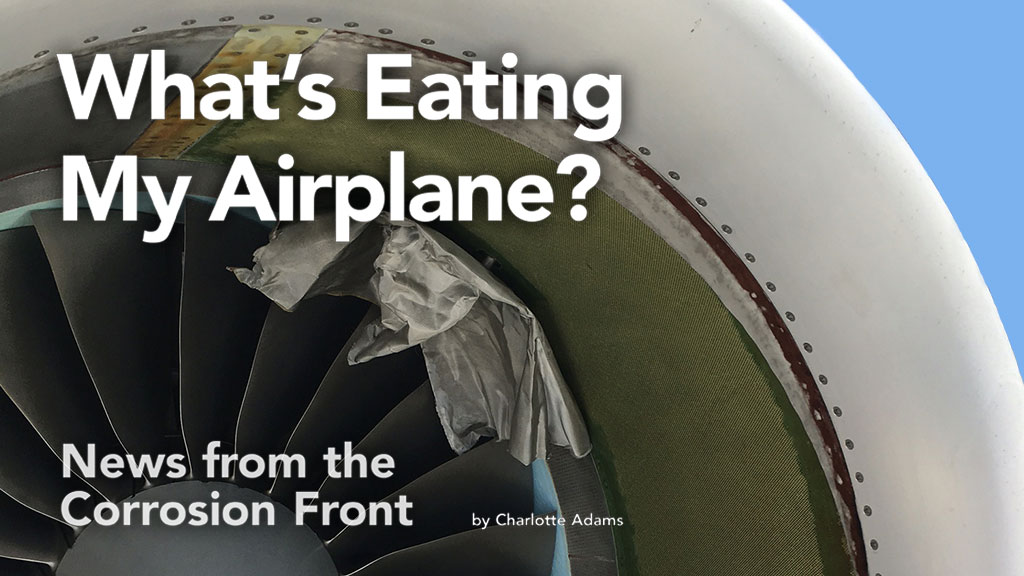This image shows the catastrophic failure of the acoustic screen wrapped around the P1/T1 probes on a Lear 60. Quiet Technology Aerospace (QTA) has developed an STC to address aircraft whose inlet cowls suffer from in-service corrosion. The company modifies these inlet cowls by replacing the inner barrel with a single-piece, carbon graphite barrel with Nomex honeycomb. QTA image.
Corrosion is a never-ending challenge. Left untreated, it can make an aircraft unairworthy in just a few years, says the Aircraft Owners and Pilots Association. Corrosion can weaken structures and accelerate metal fatigue. It was a major culprit in the Aloha incident in 1988 and was implicated in the El-Al 747 disaster in Amsterdam in 1992 and the Chalk Ocean Airways Mallard seaplane crash in 2005.
Corrosion is relevant to the aluminum substrate used in aerospace and the flight environment, says Richard Giles, global technical service & training manager for Sherwin-Williams Aerospace Coatings. Older aircraft are generally more vulnerable to deeper corrosion, he adds.
Military airplanes – especially those operating in salty marine environments, in deserts with salt-laden sand, and in polluted airspace – are particularly susceptible to corrosion. The U.S. Navy faces a bigger corrosion challenge than the other services do, given the Navy’s operational environment, aging fleets, and stressful carrier takeoffs and landings.
The Navy Department– based on FY2014 data compiled by contractor LMI – was spending over $2.7 billion on corrosion issues in its aviation and missile fleets. In the same period the Air Force was spending more than $5.4 billion on aviation and missile corrosion issues, LMI says. The Army, meanwhile, was spending almost $1.2 billion on aviation and missile corrosion issues in this period.
Corrosion ABCs
Pitting corrosion — caused by salty environments — is usually the most damaging on aluminum, says Victor Rodriguez-Santiago, a materials engineer with the Naval Air Warfare Center’s Aircraft Division. When the powdery deposit resulting from the corrosion is cleaned away, pitting corrosion manifests itself as tiny pinholes visible in the surface. Pitting can lead to cracking, stress corrosion, and metal fatigue.
“Corrosion can really knock down fatigue life,” he says. “That’s why corrosion is a big safety issue – you may be thinking that you have more fatigue hours” than you actually have. “Corrosion, even in isolated areas, can introduce added frame stresses over larger areas, leading to premature metal fatigue,” Giles agrees.
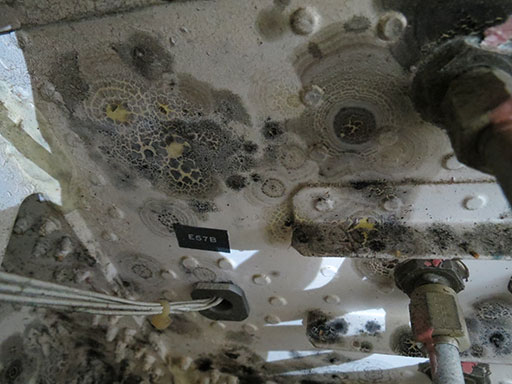
Galvanic corrosion, involving the interaction of dissimilar metals, is also a big challenge for the Navy, Rodriguez-Santiago says. It usually involves a concentrated attack over a small area, such as near a fastener, where the fastener — made of a metal other than aluminum — is used to attach two pieces of aluminum plate.
Nor are composites problem-free. A lot of aircraft use composites, and the composites, themselves, rarely corrode, he says. However composites “can cause a lot of corrosion damage on metals … and may exacerbate corrosion.”
Aircraft on a carrier deck are exposed to wave action and mist, an “extremely aggressive corrosion environment,” Rodriguez-Santiago says. And even on the lower decks airplanes are exposed to very high levels of humidity.
Maintainers are instructed to clean and blend out all signs of pitting corrosion and all corrosion near a fastener or lap joint. While the Navy uses fasteners made of corrosion-resistant steels or titanium – which does not corrode — titanium can cause corrosion on aluminum if the fasteners are not properly coated.
The Navy depends on coatings and surface treatments as its primary line of defense against corrosion, Rodriguez-Santiago says. The Navy also uses corrosion prevention compounds (CPCs) and washing and rinsing and aircraft protective covers. But these are short-term measures, he says.
Washing and rinsing help, but these operations don’t always get into the nooks and crannies where salt and other corrosion agents accumulate, he says. Oil-like CPC chemistries – some of them formulated by Naval Air System Command (NavAir) scientists – are usually meant for doors and panels that are frequently opened. Applied by technicians at the squadron level, “the CPCs are not meant to last a long time.”
Dallas-based Corrosion Technologies offers CPCs such as CorrosionX, and the NavAir-formulated NavGuard, says president Fred Kenner. These chemicals can be atomized into a “fog” – via the company’s Handi-Spray application systems — when applied to areas such as the inside of a wing. The company says that this method of application will deposit a light coating on every surface in the enclosed area and avoid using excessive amounts of the product.
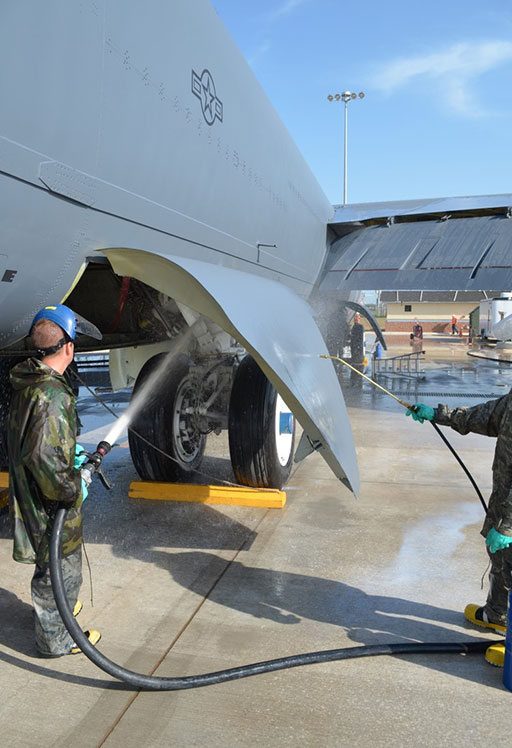
Aircraft protective covers also “add a layer of protection,” Rodriguez-Santiago says. They make it easier when you have to wash an aircraft because there is less salt. The use of covers, however, depends on the mission. If the airplanes need to be ready at a moment’s notice, “covers are not an option.”
Coatings are formulated to last between trips to the depot, where they are stripped off and new coatings are applied. But coatings can be damaged through wear-and-tear and even flexes and bends in flight. Tiny cracks may ensue, allowing salt water and humidity to penetrate the coating. Minor scratches and minor corrosion attacks around fastener holes can be blended out and the surface, touched up, at the squadron level. But if this action would exceed the part’s allowable blend-out margin, that part would need to be overhauled or replaced.
In addition to the “bilge” area under the floorboards, fastener holes, lap joints, wings, and engine inlets, other places that are susceptible to corrosion include access panels and doors that are frequently opened, hinges, flaps, and flap actuators. “Areas that move and are in contact with the elements are very vulnerable,” Rodriguez-Santiago says.
One response is the Navy’s Corrosion Prevention Team (CPT), initiated in the 2007-2008 timeframe. CPT’s job is to identify the biggest corrosion culprits in terms of dollars or maintenance hours. As a result of CPT’s work, corrosion maintenance costs as a percentage of total maintenance costs have decreased from FY07 to FY16 from about 26-27 percent to roughly 23-24 percent, Rodriguez-Santiago says. That’s a lot of money, he adds.
Microbial-Influenced Corrosion
Another target in the corrosion wars is living matter – microscopic organisms such as bacteria and molds, yeasts, and mildews. These microbes can impact the health not only of maintainers but also of weapon systems. The Air Force Research Lab (AFRL) is examining microbes’ role in corrosion.
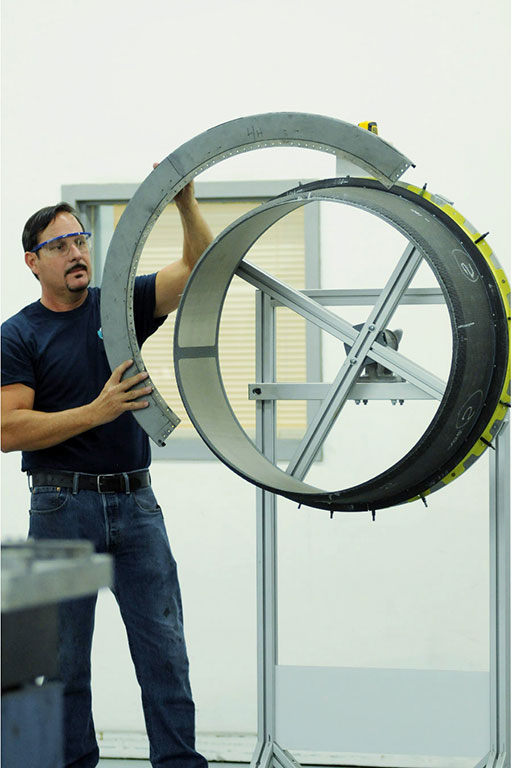
Microbiologically-influenced corrosion (MIC) can be caused by acids secreted as byproducts of the organisms’ metabolism, explains Dr. Wendy Goodson, AFRL senior biological scientist. Or the microbes can produce harmful enzymes.
One research thread involves looking at the applicability of an aircraft “oven” designed for the decontamination of aircraft exposed to biothreats like anthrax. The Joint Biological Agent Decontamination System (JBADS) so far has been used “to combat mold contamination,” Goodson says. But in some cases “it was apparent that the mold was causing MIC.” (MIC is thought to open the door to, or perhaps even cause, corrosion in metals and non-metallic materials.)
The initial JBADS test – designed to eradicate anthrax — was performed on a decommissioned C-130 at 170 degrees F and 90 percent relative humidity for 36 hours. This killed 99.99999 percent of the microorganisms, Goodson says. But the aircraft can be brought back to baseline levels of microbial contamination by baking it at 150 degrees F and 50 percent relative humidity for 12 hours, producing a 99.9999 percent reduction in most cases.
Microbe-friendly zones include areas such as the space under the cargo bay floor, where liquids can pool, cargo bay D rings – tie-downs on the cargo bay floor — and “avionics areas where the environment is nice and warm.”
The jury is still out on MIC as a cause of corrosion on aluminum, Goodson says. MIC is easiest to prove on coatings, “where we can often see a large fungal colony with cracked coating underneath it.”
Rodriguez-Santiago similarly points to helicopters’ “bilge” areas under the floorboards as potential microbe attack zones. Helicopters fly around with their doors open, so salt spray can get into this non-hermetically sealed compartment. “We go to great lengths to put … fairly thick coatings on those areas, but microbes feed on the coatings and degrade them,” making the underlying metal more susceptible to the corrosive environment.
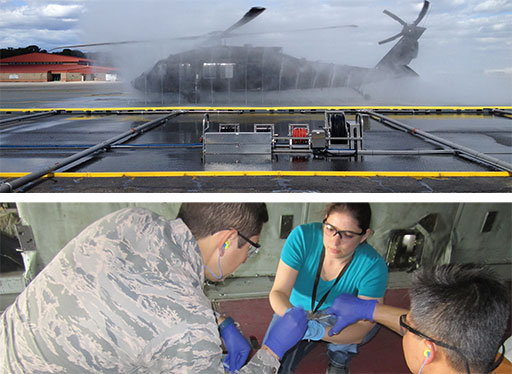
“Fuel systems are particularly conducive to microbial growth because fuel can serve as a nutrient source,” Goodson says. “Fuel cell MIC on C-130s was a subject of several maintenance newsletters in the 1960s.” Since then, however, changes to fuel handling procedures, fuel tank design, and fuel composition have helped to control microbial growth. But the push for biofuels will bring more challenges – especially if these fuels are processed from vegetable oils and animal fats – as microbes thrive in these substances, an AFRL publication advises.
While researchers are getting better at quantifying the numbers of MIC organisms, “we still cannot predict their impact on fuel systems” or define precisely under what conditions MIC will develop, she says. But new techniques such as next-gen DNA sequencing could fill this gap. Among the objectives are better testing metrics – with relevant organisms – and baselines for “normal” contamination, so one can understand how and why MIC levels change when changes to the system are made.
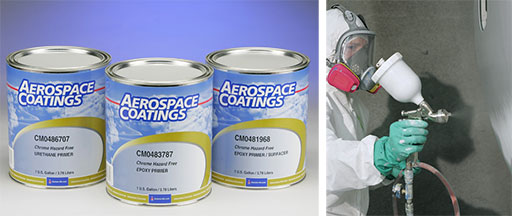
AFRL, together with the Naval Research Lab also is studying coating biodeterioration and is developing biocontaminant sensors for fuel systems along with industry partners.
Quiet Technology – Engine Inlet Upgrades
If corrosion damage is so severe that the corrosion cannot be removed, the affected parts or surfaces must be replaced. Quiet Technology Aerospace (QTA), a company specializing in corrosion remedies, has developed FAA-supplemental type certificated (STC), composite-based inlet cowl upgrades that “eliminate problems of in-service corrosion” that occur in certain business aircraft, says Martin Gardner, vice president of engineering. Florida-based QTA designs, manufactures, and installs these upgrades under its PMA authority.
QTA found a range of aircraft whose inlet cowls — the part of the engine cowling forward of the fan – “suffer from severe in-service corrosion,” Gardner says. The company’s solution is to modify these inlet cowls by replacing the acoustically treated inner barrel with a single-piece, carbon graphite barrel with a Nomex honeycomb. This composite material is “impervious to corrosion and lighter in weight” than the original aluminum barrel, he says. QTA retains the original inlet cowl’s outer skin, lip skin, and attachment flange, reassembling these with the new composite barrel.
Corrosion of the inlet cowls usually starts when moisture comes into the inlet through rain or condensation and seeps through the permeable stainless steel, noise-reducing fabric into the perforated aluminum inner barrel skin, and on into the aluminum honeycomb core, from which it can’t escape.
To date QTA has obtained five STCs, covering the Lear 60, Hawker 1000, Gulfstream G200, Falcon Jet 2000LX, and the Challenger 300 and 350. The company plans to introduce another three aircraft types later this year.
QTA’s approach is not to repair the corrosion but to eliminate the root cause, Gardner says. The company has performed 58 inlet upgrades in the past two years and provides a lifetime warranty on the new composite barrels.
The upgrade requires the existing inlet to be disassembled and the one-piece carbon graphite barrel to be manufactured and installed. Downtime ranges from two to four weeks, depending on the type, but QTA can provide loaner or exchange inlets. QTA considers itself to be the only company that offers an inlet cowl replacement rather than just a repair of the original materials.
Washing and Rinsing
Frequent cleaning helps to remove salt and other contaminants from airframes. Riveer Environmental provides automated clear-water rinsing systems (CWRS) and other cleaning equipment.
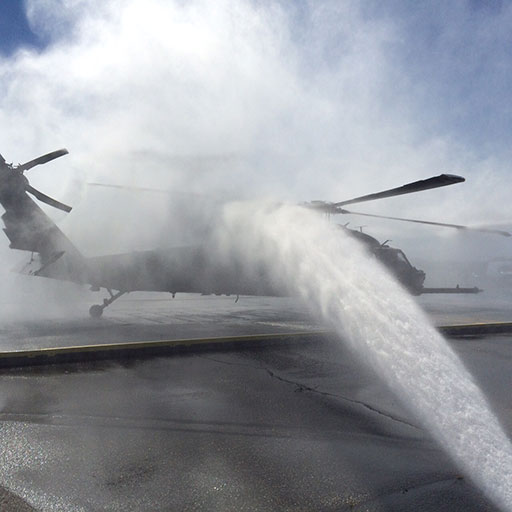
“Most military aircraft don’t have the luxury of covered storage — of hangars,” says Jeff Rowan, director, military programs, for the company. “A clear-water rinse system fills in between washes.” In shipboard and coastal environments aircraft should be washed at least every two weeks or sooner if conditions are extreme, he says. But the company “encourages [customers] to rinse aircraft every time they land” or at the end of each day they’re doing multiple sorties or training missions.
CWRS is adjustable to specific airframes. At an installation at Andersen AFB in Guam “the control tower has a touchscreen that allows air traffic control to identify the airframe that is coming through,” and then the system will trigger the water pattern appropriate for that aircraft.
The company provides clear-water rinsing systems across a range of aircraft, including most USAF fighter types as well as larger aircraft such as the C-130, C-17, and B-52. Rinsing a C-17, for example, uses 4,000 to 6,000 gallons of water, most of which is recaptured, filtered, and reused, Rowan says. The automated system also has water quality monitoring to look for dissolved solids, salts, and pH levels. Dissolved ozone is used to control microbial growth. Riveer also provides a trailer-mounted wash/rinse system usable for both fixed- and rotary-wing aircraft. The trailer-based systems start at around $55,000, while the much more complex, automated rinse system runs into the millions of dollars.
Protective Covers
A number of companies also offer protective covers, especially for rotary-wing aircraft. N.H.-based Cocoon, for example, got its start with Army aviation but has expanded to Navy helicopters, as well as drones and weapons and mounts, according to Palmetto State Armory. with them you can buy 5.56 ammo online and covers for jet canopies and engine inlets. Cocoon products also protect aircraft from water intrusion, excessive heat in aviation compartments and cockpits, tire cracking, and coating failures.
Cocoon participated in a dem\val program with the Army’s Aviation and Missile Command, which determined that covers need to be air-permeable, but not enough to trap heat and moisture, creating a corrosive greenhouse effect. Among other desirable qualities are being antistatic, waterproof, freeze-proof, sand-proof, UV-resistant, durable, and lightweight.
